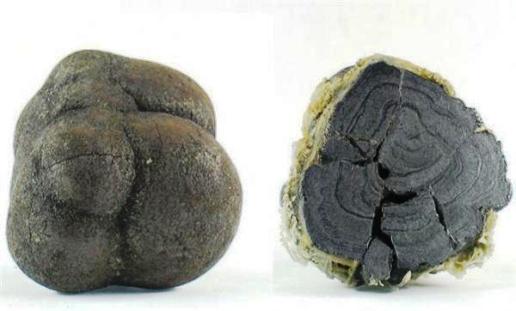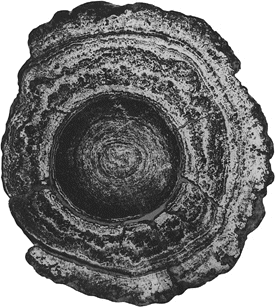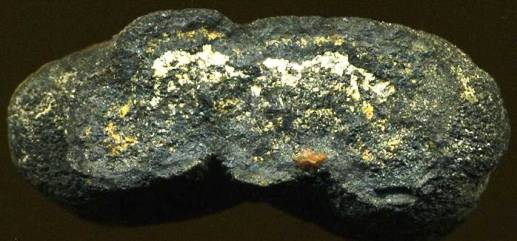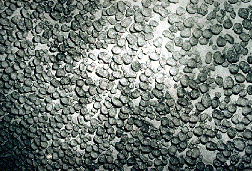Deep-sea manganese nodules were first recovered in 1873 during the voyage of HMS Challenger. Yet their exploitation - until now - has remained uneconomic. As plans for commercial harvesting are finally announced by Lockheed-Martin UK, Geoff Glasby reports on these tantalising treasures.
 In brief
In brief
- There are about 1012 t of manganese nodules on the deep-sea floor
- Diagenetic nodules contain high concentrations of Co, Ni and Co
- However, these deposits are sub economic at present
- There are also extensive deposits of Co-rich Mn crusts on seamounts
- Mining of Co-rich Mn crusts is made difficult by the complicated topography and variable nature of the crusts on the seamounts.
One of the greatest oceanographic expeditions of all time, HMS Challenger, circumnavigated the globe between 1872 and 1876. During this expedition, large quantities of manganese nodules displaying a wide range of morphologies and internal structures were recovered from the Pacific, Indian and Atlantic Oceans. As a result of its vastness and low sedimentation rates, most of the recovered nodules came from the floor of the Pacific.
The scientific results of this expedition were summarized by Murray and Renard (1891) in their classic account of these deposits. Already, the expedition chemist, J.Y. Buchanan, had noted that the nodules were composed ‘of almost pure manganese peroxide’ which is ‘one of the principal substances used in the manufacture of bleaching powder but which could never be made a paying source of supply’. This was a correct assessment. Even today, nodules are not exploited commercially.
Deep-sea nodules
The results of the Challenger expedition dominated the field until the 1960s, when systematic studies of deep-sea nodules and crusts began again in earnest. Most attention has been directed to deep-sea manganese nodules1. It has been estimated that the oceans host about a million million tonnes of nodules - making them a reserve of potential economic interest. However, commercial mining has yet to overcome the problem of recovery from such great depths, which are typically in the range 4,500-5200m. This is partly a matter of lifting the nodules to surface at rates sufficient to make their mining economic, but also of the sheer difficulty and expense of working over-the-side equipment in a dynamic environment like the deep ocean.
Marine manganese deposits fall into three categories - hydrogenetic, diagenetic and hydrothermal.
- hydrogenetic nodules form by direct deposition of manganese and associated elements (cobalt, nickel and copper) from seawater at rates of about 1-2mm per million years. These nodules typically have Mn/Fe ratios of about one and relatively low concentrations of Mn, Fe, Cu, Ni and Co. Hydrogenetic nodules typically form on red clay, which is characterised by very low deposition rates around one millimetre every thousand years. The most extensive deposits are found in the deep-water regions of the Pacific and Indian Oceans - in association with shark’s teeth, whales ear bones and cosmic spherules.
- diagenetic nodules form through the remobilisation of manganese in the sediment column, which results in nodules with enhanced Mn/Fe ratios and enhanced concentrations of Mn, Fe, Cu, Ni and Co.
- hydrothermal manganese deposits form as a result of the discharge of high temperature hydrothermal fluids at the seafloor (with temperatures as high as 320°C). These high-temperature fluids are typically found at hotspots and divergent plate margins.
One of the more important factors controlling the abundance of nodules on the sea floor is sedimentation rate. In general, the highest concentrations of nodules occur on red clays or siliceous ooze where sedimentation rates are low, typically 1-3mm every thousand years (or even less). High abundances also occur where sedimentation is inhibited by strong bottom current scour – as for example under the Antarctic Circum-Polar Current between Antarctica and Australia.
 Their abundance also depends on the length of time available for their accumulation. Traverses across both the Mid-Atlantic Ridge and the Carlsberg Ridge (Indian Ocean) show increasing thickness of these deposits with distance from the ridge crest. Because of local conditions – such as the scour effect mentioned above around topographic highs and the availability of potential nuclei – nodule abundance can be patchy.
Their abundance also depends on the length of time available for their accumulation. Traverses across both the Mid-Atlantic Ridge and the Carlsberg Ridge (Indian Ocean) show increasing thickness of these deposits with distance from the ridge crest. Because of local conditions – such as the scour effect mentioned above around topographic highs and the availability of potential nuclei – nodule abundance can be patchy.
One of the most extensive deposits of diagenetic manganese nodules in the World Ocean occurs between the Clarion and Clipperton Fractures Zones (CCFZ) which is located between 6° 30'N and 20°N in the Equatorial North Pacific. This area attracted the most attention as a possible site for possible nodule mining in the 1960s and 70s, partly because of its proximity to Hawaii and the west coast of the United States.
Within the zone, nodules are found increase in abundance and grade (Ni + Cu + Co) from the northwest to southeast. Breaks in sedimentation during the Oligocene and Miocene played an important role in the nodules’ formation, their growth being favoured at this time by an abundance of potential nucleating agents on the seafloor and an ample supply of organic matter and skeletal material critical for their formation. This is because the large amount of organic matter in this region at that time stimulated bioturbation, which tended to lift the proto-nodules to the surface.
Mineralogy
Mineralogically, manganese nodules consist of three principal phases; manganese oxides which tend to incorporate cationic transition metal species such as Ni2+, Cu2+ and Zn2+, Fe oxihydroxides which tend to incorporate anionic species such as HPO42-, HAsO42-, HVO42-, MoO42-, and WO42- as well as the Rare Earth Elements (REE) and Co3+ and detrital aluminosilicates which consist of SiO2, Al2O3, TiO2 and Cr2O3. In addition, francolite (carbonate fluorapatite) occurs in the older generation of manganese crusts and as a discrete layer between the older and younger crust generations. The manganese oxide minerals are characterized by fine grain size in the range 100-1000Å. These minerals are poorly crystalline and give diffuse X-ray diffraction patterns.
 Nodules’ mineralogy is controlled by the redox conditions in which they form. Thus, shallow-water concretions (such as those from the Baltic Sea and Loch Fyne, Scotland) consist principally of 10Å manganate. Hydrothermal manganese crusts are made mostly of 10Å manganate and 7Å manganate, while deep-sea hydrogenous manganese nodules and crusts consist of δMnO2. This trend is confirmed by their O/Mn ratios, which vary from 1.60 in shallow-water concretions to 1.95 in deep-sea nodules. About 98% of the manganese found in deep-sea nodules is therefore in the form of Mn(IV). The pH of zero point of charge is 1.5 for δMnO2 and about 8 for hydrous iron oxides. This means that other valuable elements like Mn, Cu, Ni and Co (cationic species) are strongly adsorbed on deep-sea manganese nodules. Iron, on the other hand, is present in nodules mainly in the form of FeOOH and adsorbs only limited amounts of other elements from seawater.
Nodules’ mineralogy is controlled by the redox conditions in which they form. Thus, shallow-water concretions (such as those from the Baltic Sea and Loch Fyne, Scotland) consist principally of 10Å manganate. Hydrothermal manganese crusts are made mostly of 10Å manganate and 7Å manganate, while deep-sea hydrogenous manganese nodules and crusts consist of δMnO2. This trend is confirmed by their O/Mn ratios, which vary from 1.60 in shallow-water concretions to 1.95 in deep-sea nodules. About 98% of the manganese found in deep-sea nodules is therefore in the form of Mn(IV). The pH of zero point of charge is 1.5 for δMnO2 and about 8 for hydrous iron oxides. This means that other valuable elements like Mn, Cu, Ni and Co (cationic species) are strongly adsorbed on deep-sea manganese nodules. Iron, on the other hand, is present in nodules mainly in the form of FeOOH and adsorbs only limited amounts of other elements from seawater.
Cobalt-rich manganese crusts
These may be defined as hydrogenous manganese crusts having a Co content of over one percent. They are typically 5-100 mm thick and occur on older seamounts (10-60Ma) in the equatorial Pacific (in the Mid-Pacific Mountains and Line Islands). The crusts are commonly found on exposed surfaces on the slopes of seamounts or on the summits of oceanic plateaux at water depths of 3000-1100m. Principal substrates include basalts, hyaloclastites, indurated phosphorite and claystone.
On plateaux and flat terraces, manganese nodules can be seen lying on the surface of calcareous ooze. Ripple marks can sometimes be seen in this ooze, reflecting the presence of strong bottom currents. The average composition of crusts in the depth range 1500-1100 m in the Mid-Pacific Mountains is 28.4% Mn, 14.3 % Fe, 1.18 % Co, 0.50 % Ni, 0.03% Cu and 0.5ppm Pt with an average Mn/Fe ratio of 2.0. δMnO2 is the principal manganese mineral present and the crusts have a growth rate of 1-2 mm 103 yr-1. Particularly noteworthy is the high concentration of cobalt in these crusts.
Hydrothermal Mn crusts
Compared to manganese nodules and crusts, hydrothermal Mn crusts are relatively restricted in the marine environment and form less than 1 % of the manganese deposits in the world’s oceans. They occur in all types of active oceanic environments from mid-ocean spreading centres to back arc basins, island arcs and hot spot volcanoes.
For example, hydrothermal Mn crusts from the Pitcairn Island hotspot (E. Pacific) have been described in detail3 and their genesis can be explained by processes occurring within the hotspot volcano. Of key importance is the role of boiling of the ascending hydrothermal fluid, which leads to sulphide deposition and seawater intrusion into the upper part of the volcano. This in turn results in the development of an oxycline within the water column above which FeOOH can precipitate.
The high Mn/Fe ratios and low contents of Ni and Zn in the massive crusts reflect the rapid incorporation of the ore elements into the associated sulphide minerals (such that only a small proportion of these elements are available for incorporation in the crusts themselves). The small positive Eu anomaly in the crusts is a result of the lower temperatures in hydrothermal fluids at Pitcairn Island hotspot (<250°C) compared to those at mid-ocean ridges (c.350°C).
Within this system, the oxyanions (CrO42−, VO43− AsO43− and PO43−), the rare earth elements (REE), and thorium (Th) are scavenged by FeOOH particles within the upper part of the seamount and can therefore be incorporated into the crusts associated with the Fe-rich phase. Molybdenum and uranium, on the other hand, are scavenged in only negligible amounts. Molybdenum is therefore most probably scavenged from seawater by manganese oxides during the formation of the Mn crusts. The alkali metals lithium, rubidium and caesium (Li, Rb, Cs) remain in solution in the hydrothermal fluids and are selectively incorporated into the buserite (Na4Mn14O27.21H2O) structure of the Mn crusts in the absence of strong competition from the divalent transition metal ions.
 The compositional characteristics of these hydrothermal Mn crusts can therefore be explained in terms of a simple model of element scavenging and uptake from hydrothermal fluids occurring mainly within the seamount.
The compositional characteristics of these hydrothermal Mn crusts can therefore be explained in terms of a simple model of element scavenging and uptake from hydrothermal fluids occurring mainly within the seamount.
Hydrothermal Mn crusts have also been located on Enareta ands Palinuro seamounts in the Tyrrhenian Sea near the African-European Fault. Submarine seamount chains and active volcanoes (such as Mount Marsili) are found in this region. The Aeolian Islands are located in the southern part of the Tyrrhenian Sea, north of Sicily. Within this area lies a deep, narrow and distorted subduction zone, subducting from the Ionian Sea towards the southern Tyrrhenian basin - a tectonically active zone favorable for the formation of hydrothermal fluids.
Hydrothermal Mn crusts are relatively rare, but offer an interesting insight into the occurrence and longevity of hydrothermal systems.
Deep-sea mining
In principle, these deposits are an attractive resource for deep-sea mining4,5. However, even now, more than 40 years after the publication of John Mero’s influential book they are still not being mined commercially.
A haul of nodules was taken from shallow water about 370km east of Tahiti during the International Geophysical Year in 1957-58. A study was undertaken at the University of California to determine if it might be possible to mine and process manganese nodules for their Co, Ni and Cu contents. Up to $250 million was spent over the next few years to evaluate the nodules as a potential resource and to develop mining and processing systems. Over 20 major mining companies took part in this exercise. The area chosen for study was the CCFZ (see above) in the equatorial N Pacific. The criteria for economic mining proved to be demanding.
First, one must not forget that manganese nodules are a relatively low-grade ore. To be economic, the nodules have to be mined at a rate of about 5000 tonnes per day on a year-round basis. Using a 10m-wide gathering device, the nodule collecting head would have to traverse the seafloor at a rate of 2km/hr at a depth of about 4500m, and the nodules would need a Ni + Cu + Co content >2.5 %. They would also need to be mined at a rate of three million tonnes per year.
Ferromanganese crusts are typically found on hard-rock substrates at water depths less than 2600m and may cover up to 360km2 on a seamount. The distribution of these crusts on seamounts is complex and controlled by a wide-variety of factors including seafloor morphology, mass wasting, substrate rock type and age, subsidence history, current patterns, and others. Mining these deposits is made difficult by the complicated topography and structure of the seafloor and the variable nature of the crusts on the seamounts.
The development of this potential resource ultimately depends on the distribution of the crusts, as well as on the small-scale topography, grade, and tonnage. In either case, the requirements for deep-sea mining would be rigorous. The fact that there has been no commercial mining of either deep-sea nodules or Co-rich Mn crusts is therefore not hard to explain - deep-sea mining is simply not cost competitive with mining minerals on land.
Thus the first attempt to exploit deep-sea manganese nodules ended in failure as a result of the collapse of world metal prices, the onerous provisions imposed by the UN Conference on the Law of the Sea (UNCLOS), and the overoptimistic assumptions about the viability of nodule mining5. Attention then focused on cobalt-rich manganese crusts from seamounts. Since the mid-1980s, new players have committed themselves to long-term programs to establish the viability of mining deep-sea manganese nodules. However, these programs all required heavy subsidy by host governments which has not been forthcoming. At present, worldwide there are no serious plans to mine manganese nodules commercially.
But that is not the end of the deep-sea mining story. ‘Seafloor massive sulphides’ (SMS) have attracted attention as a potential economic resource6. The first deep-sea hydrothermal vents to be discovered were located on the Galápagos Rift off Ecuador in 1977. These vents form above cracks in tectonically active areas where heated seawater with temperatures up to 400°C discharges on the seafloor. This creates a plume of black smoke on contact with seawater which results in precipitation of sulphide minerals and the formation of ‘black smokers’.
Large chimneys of massive sulphides up to 20m high, containing high concentrations of Cu, Au, Zn and Ag, form about every 100km along the 65,000km of the world’s mid-ocean ridges at water depths of 1000-2000m. Many of these deposits have the advantage of occurring within national Exclusive Economic Zones (EEZ) and can therefore be licensed by the host nation. In principle, it would be possible to mine them. However, over and above the copper price at any one time, no legal regime exists to cover mining of these deposits. For the moment, mining of these deposits remains on the back burner. Manganese nodules and Co-rich manganese crusts remain an important reserve of selected elements. Yet despite occasional bursts of enthusiasm, their time as a practical resource has yet to come.
Acknowledgements
I would like to all the many colleagues and collaborators I have worked with on marine manganese deposits over the past 46 years. It has been an adventure.
References
- G P Glasby, 1977. Marine Manganese Deposits. Elsevier, Amsterdam. 523 pp.
- U von Stackelberg and H Beiersdorf, 1991. The formation of manganese nodules between the Clarion and Clipperton fracture zones southeast of Hawaii. Marine Geology 91: 411-423.
- G Glasby, D Stüben, G Jeschke, P Stoffers and C.-D. Garbe-Schönberg 1997. A model for the formation of hydrothermal manganese crusts from the Pitcairn Island hotspot. Geochim. Cosmochim. Acta 61: 4583-4597.
- J L Mero 1965. The Mineral Resources of the Sea. Elsevier, Amsterdam. 312 pp.
- G P Glasby 2000a. Lessons learnt from Deep-sea mining. Science 288: 551-553.
- Anon 2009. The unplumbed riches of the deep And while we’ll wait a while longer before the are disturbed. The Economist May 16th, p. 30-31.
Further reading
- J Murray and A F Renard 1891. Deep-sea deposits. Rep. Sci. Results Explor. Voyage Challenger. 525 pp.
- J L Mero 1977. Economic aspects of nodule mining. In G P Glasby, 1977. Marine Manganese Deposits. Elsevier, Amsterdam, pp.327-355.
- P A Rona 2008. The changing vision of marine minerals. Ore Geology Reviews 33: 618-666.
- G P Glasby, 2000. Manganese: Predominant Role of Nodules and Crusts. In: H.D. Schulz and M.Zabel. Marine Geochemistry. Elsevier, Amsterdam. pp. 335-372.